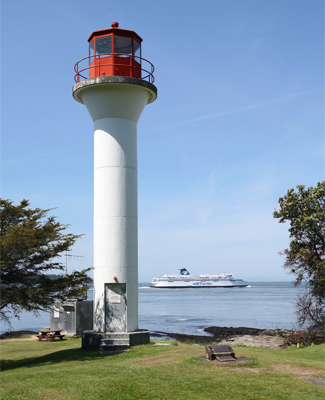Active Pass Lighthouse
Heritage Lighthouse
Mayne Island, British Columbia

General view
(© Kraig Anderson - lighthousefriends.com)
Address :
Georgina Point Road, Mayne Island, British Columbia
Recognition Statute:
Heritage Lighthouse Protection Act (S.C. 2008, c 16)
Designation Date:
2013-12-20
Dates:
-
1969 to 1969
(Construction)
-
1885 to 1885
(Established)
Other Name(s):
-
Active Pass Lighthouse
(Designation Name)
Description of Historic Place
The Active Pass Lighthouse is a 13.7 metres (45 feet) tall cylindrical concrete structure. It widens at the top to support a red octagonal metal lantern. It is located on the north eastern extremity of Mayne Island in the Georgia Strait. Built in 1969 as a coastal light, it marks the eastern entrance to Active Pass.
There are four related buildings on the site that contribute to the heritage character of the lighthouse: (1) the ca. 1940 Lightkeeper’s residence; (2) the 1983 Storage shed building; (3) the 1977 Engine and Radio room; (4) and, the 1982 Garage.
Heritage Value
The Active Pass Lighthouse is a heritage lighthouse because of its historical, architectural, and community values.
Historical values
The third lighthouse built on the site, the Active Pass Lighthouse reflects the modernization and evolution of marine aids to navigation in the 1950s and 1960s. It is a very good example of the theme of improvements in the navigation system of Canada, particularly in the Georgia Strait sector.
Since its establishment in 1885, the Active Pass lightstation has made it easier and safer for marine traffic to travel between Victoria and Vancouver. The three lighthouses have played a significant role in the lives of the region’s mariners, since it is a very busy waterway.
Architectural values
With its smooth white concrete circular shaft, which tapers at the top to support a metal lantern, the Active Pass lighthouse stands out because of the simplicity of its construction and its minimalist and modern aesthetic. It is an excellent example of the visual qualities associated with the “apple core” design, which was a popular design on the West Coast at the end of the 1960s and early 1970s.
Built with common and durable materials from a variation of a standard “apple core” plan, the lighthouse is a clear expression of functional design and the Department of Transport’s desire to minimize maintenance.
Community values
Because of its strategic location on Georgina Point on Mayne Island, on the shores of the Active Pass channel, the Active Pass Lighthouse is an important component of the area’s maritime character. It is a highly visible navigation landmark for ships plying on one of the busiest waterways of Canada’s West Coast. Its continuing use as a functional lighthouse has preserved its marine aid to navigation character.
The lighthouse is a symbol of the Mayne Island community. It is a site that receives numerous visitors and is greatly appreciated by the community and by tourists. It is a familiar landmark for thousands of ferry passengers who travel daily through the area.
Related buildings
Four related buildings, as listed above, contribute to the heritage character of the lighthouse.
Character-Defining Elements
The following character-defining elements of the Active Pass Lighthouse should be respected:
— its intact structural form, height, profile and balanced proportions, characterized by the “apple core” type tower design;
— its smooth circular shaft in reinforced concrete;
— its superimposed reinforced concrete circular gallery, supported by a tapered cornice that transitions from the cylindrical wall structure;
— its plain metal railing that surrounds the circular gallery;
— its octagonal metal lantern, capped by a roof with a metal cylindrical ventilator;
— its traditional red and white exterior colour scheme, that is, the white tower and the gallery accented by red features, such as the railing of the gallery and the lantern;
— its visual prominence in relation to the water and landscape.
The following character-defining elements of the related buildings should be respected: their respective built forms, profiles and proportions; their traditional red and white exterior colour schemes; their contextual relationships to the lighthouse within an historic lightstation setting.